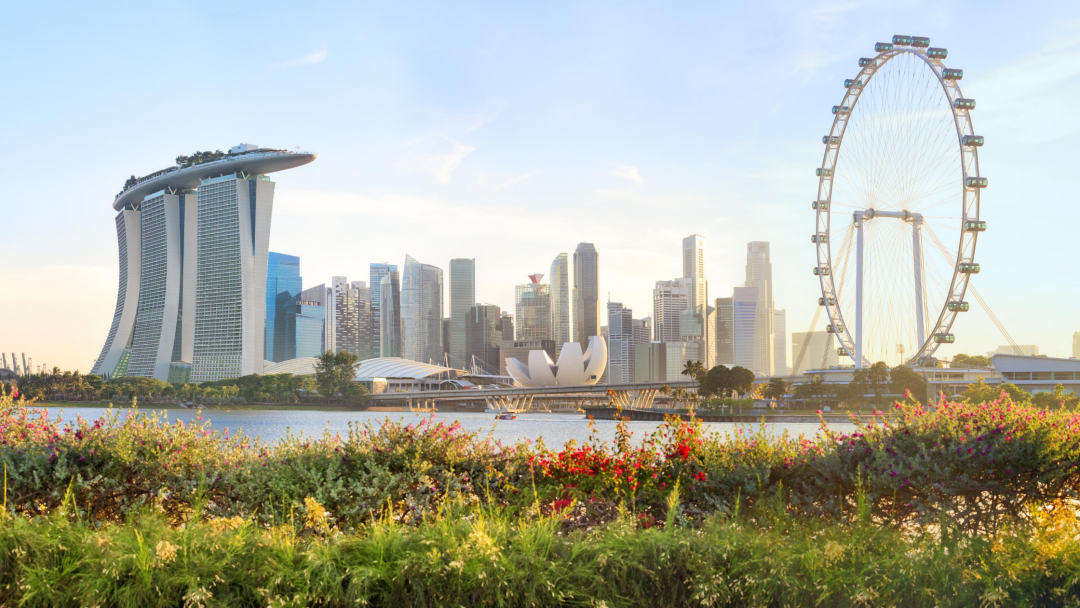This page may contain affiliate links, which means that we may earn from qualifying purchases at no additional cost to you.
This 2 day itinerary will help you maximize your weekend in Bruges for a perfect trip!
An enchanting medieval city that feels like something out of a fairytale, Bruges is a place you must visit while in Belgium. Bruges is the capital of West Flanders and is often referred to as the Venice of the North due to its many canals.
This is one of the most well-preserved medieval cities in Europe and attracts people from all over to admire the exquisite architecture as they take a step back in time.
Two days in Bruges will allow you to see all the best sights in the city without feeling rushed. On a weekend visit to Bruges you can lose yourself in the cobblestone streets, explore the fascinating historic buildings, cruise the canals in a boat tour, and eat copious amounts of Belgian chocolate and waffles.
You don’t want to miss any of the best sites in this captivating city, so be sure to read on for our perfect 2 day itinerary for a weekend in Bruges!
And if you have more time, be sure to spend a day in nearby Ghent!
Bruges 2 Day Itinerary Overview
Day 1
- Burg Square
- City Hall (Stadhuis)
- Basilica of the Holy Blood
- Grote Mrkt
- Climb the belfort
- Stop for fries
- Groeninge Museum
- Gruuthusemuseum
- Church of Our Lady
- Take a Stroll Around Minnewater Lake
Day 2
- Rozenhoedkaai
- Canal tour
- Waffle and chocolate
- Choco-story (chocolate museum)
- Frietmuseum (French fry museum)
- Museum of Folk Life
- Windmill walk
Bruges 2 Day Itinerary
Day 1
On the first day of your weekend in Bruges, you’ll be focused on the city center. A UNESCO World Heritage Site, the historical center of Bruges is characterized by striking medieval buildings, cobblestone streets, and charming shops and eateries. It’s a perfect place to wander around on foot as you take in the sights.
It might seem like we have a lot packed into this day, but many of these stops are quick visits that won’t take much time.
Burg Square
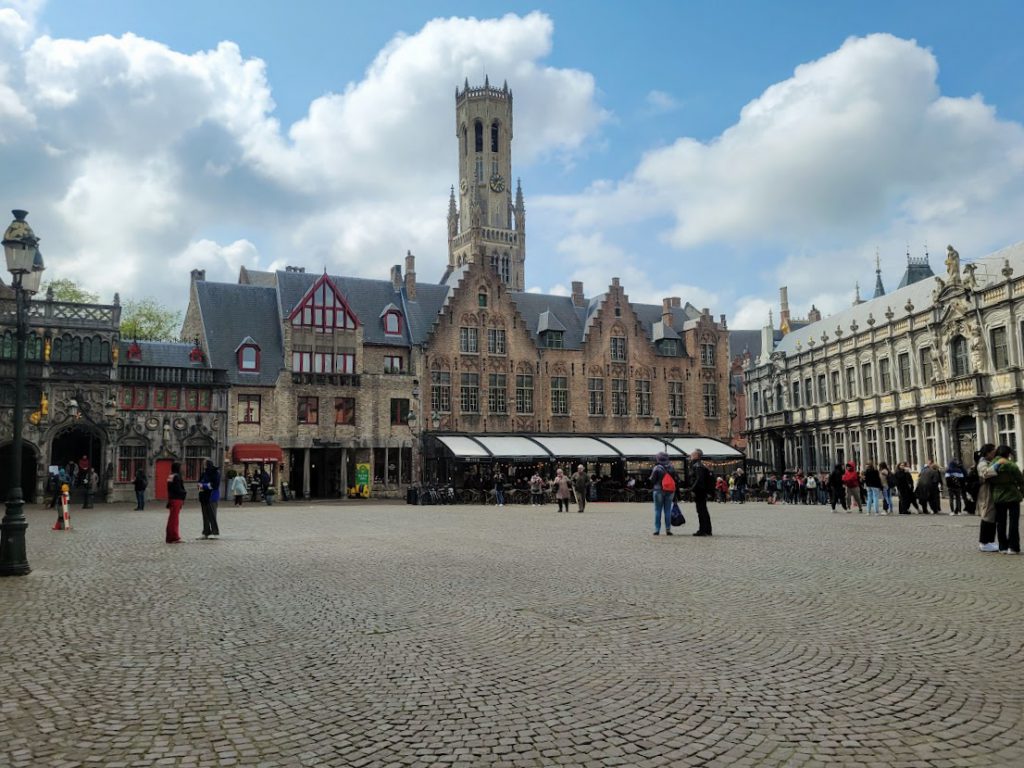

The location of the former fortress of Bruges and the political center of the city, Burg Square is one of the oldest parts of the city.
Although the fortress no longer remains, the Square is still full of significant historic buildings, including the City Hall and Basilica of the Holy Blood.
You’ll definitely want visit the square while you’re in Bruges.
City Hall (Stadhuis)
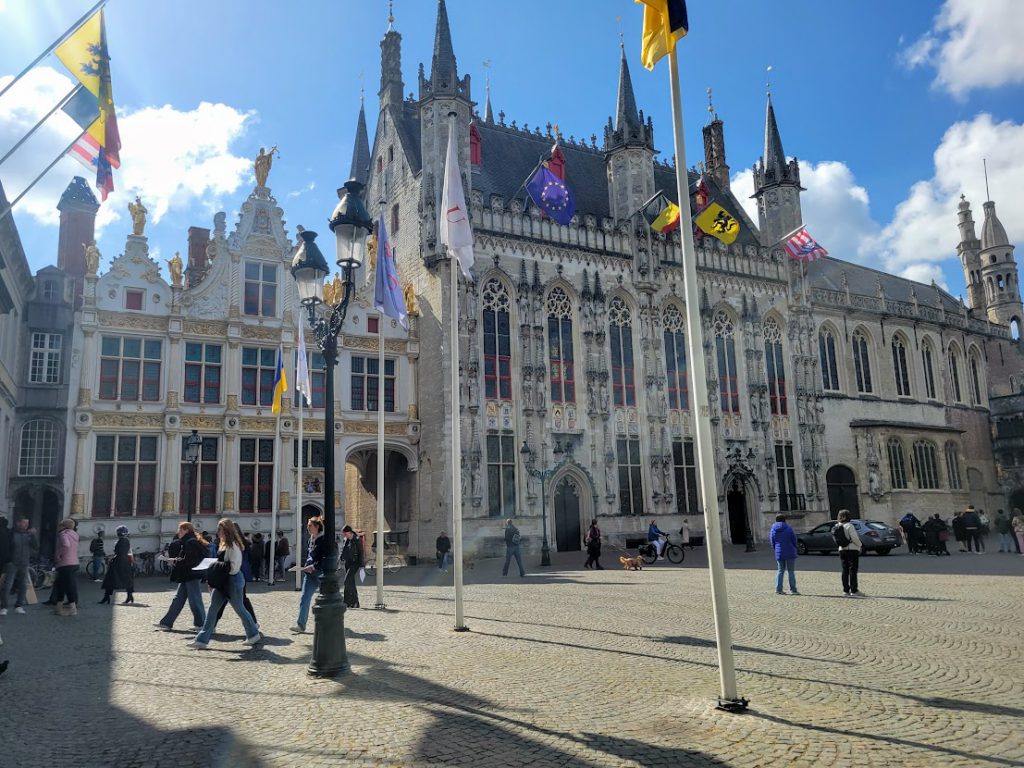

The City Hall in Bruges is one of the oldest in the Netherlands, with construction starting in 1376.
This is a quick visit, as there are only two places inside to visit. The main attraction is the Gothic Hall, a room with high ceilings and intricate murals detailing the history of Bruges.
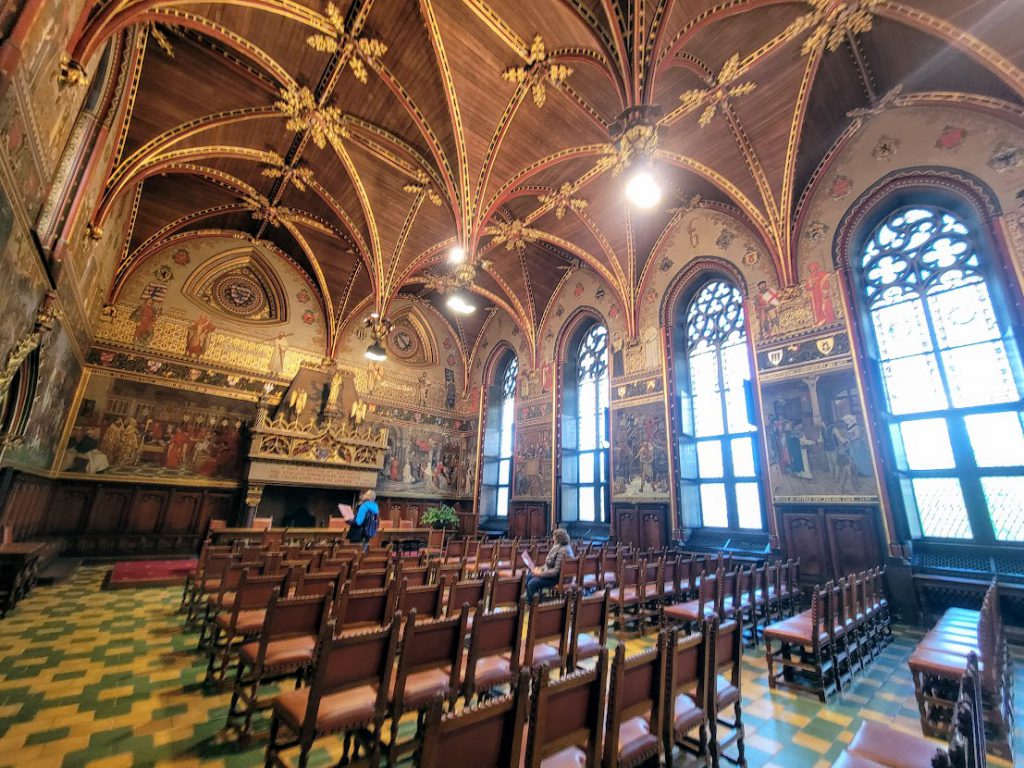

In the next room you’ll find a small museum with maps and history about the area. However, most of the information is not in English.
Entrance is included in the Musea Bruges Card, otherwise it costs €7.
Basilica of the Holy Blood


This small but beautiful basilica is tucked away in the corner of Burg Square, easy to miss if you aren’t looking for it.
The cathedral is made up of two levels built in different styles. The lower chapel is a more austere chamber built in the Romanesque style, while the upper chapel has been rebuilt over the years in the Gothic style.
The main significance of this cathedral is that it houses a vial of what is said to be Christ’s blood. It is said that the blood was collected by Joseph of Arimathea and brought to Bruges from the Holy Land during the crusades.
The vial of blood is only brought out at certain times and typically a donation is required to view it.
It’s free to enter the cathedral, but entrance to the treasury costs €3.
Grote Markt
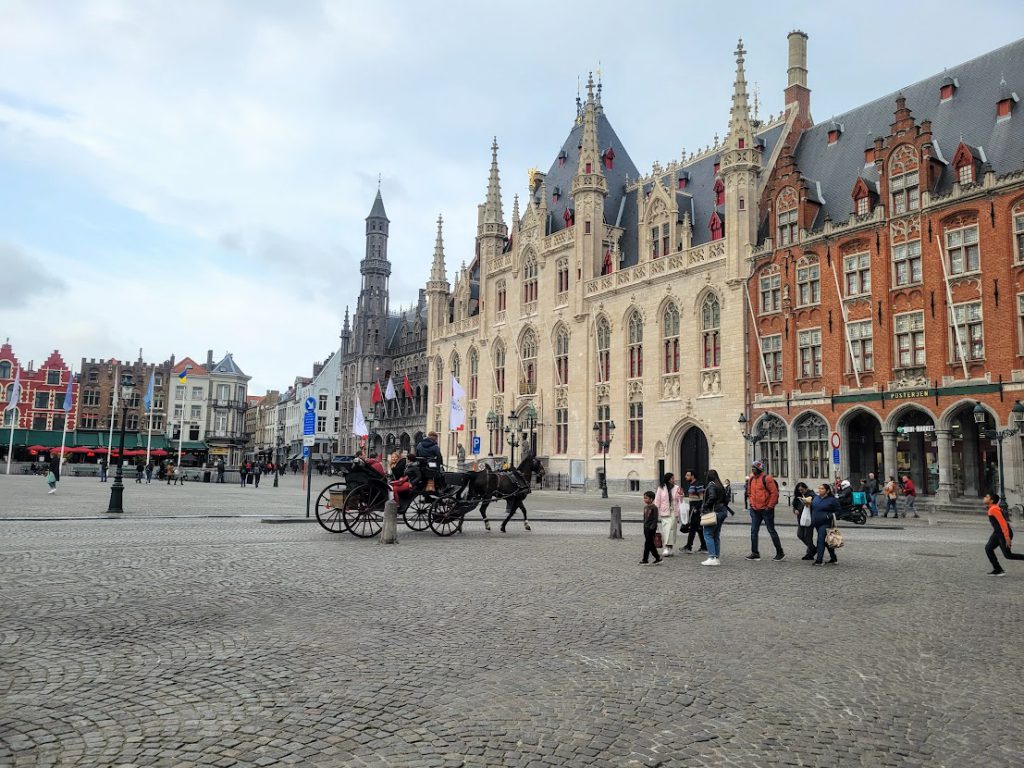

The heart of the city of Bruges is the Grote Markt, or Market Square. The square is ringed with prominent historical buildings, the most significant one being the towering belfry.
The square is a place of gathering and historically was used for festivals, fairs, and of course, markets! Today, Market Day is on Wednesdays, so if you happen to be visiting midweek you can stop by for fresh produce, cheese, meats, and flowers.
Climb the Belfort
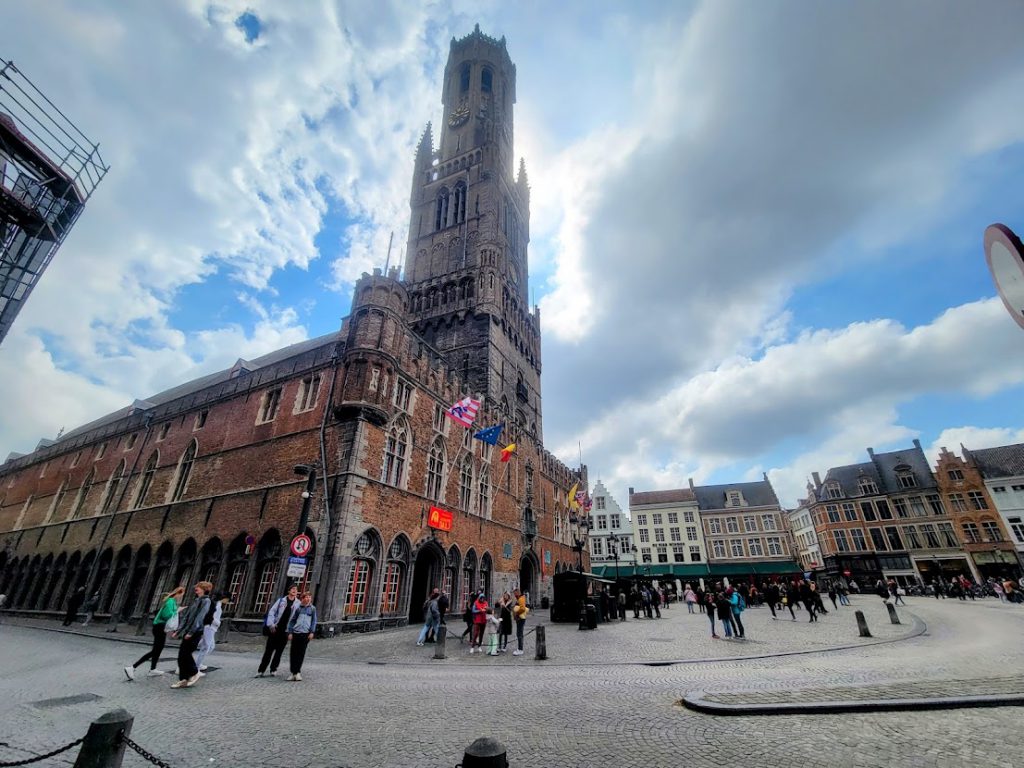

Standing at 289 feet tall, the Belfry is one of the most prominent buildings in Bruges. Although it’s a tiring 366 step climb, it’s well worth the effort to make your way to the top of the tower. From that height, you have incredible views of the town and surrounding area.
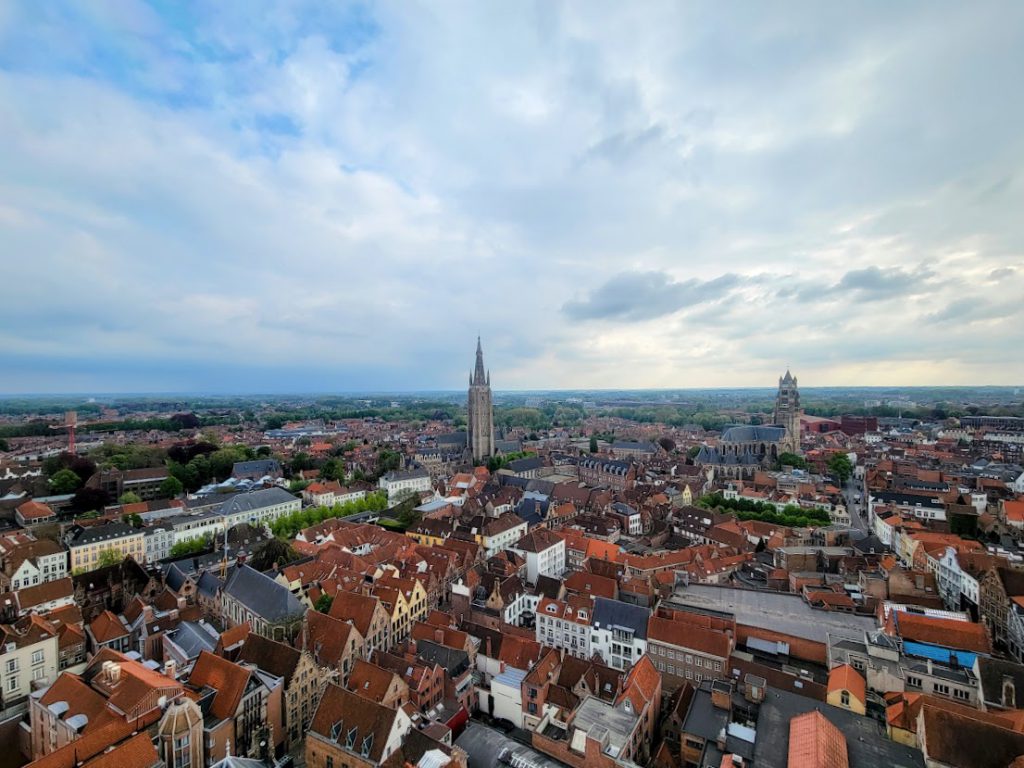

If possible, plan your visit to be at the top when the bells are ringing. It’s fascinating to see the mechanisms at work in the belltower, although be aware that it is quite loud as you’re basically standing inside the bells while they are ringing.
Note that the staircase does get very narrow, especially as you near the top. On the way up there are several levels with exhibits, so you have an opportunity to stop and catch your breath. We managed it with a baby in a baby carrier, so it’s definitely doable, just take your time.
Entrance is included in the Musea Bruges Pass, otherwise it’s €14 for adults and €12 for ages 7-25 (under 7 is free). Unlike most other museums in Bruges, the belfry is open on Mondays.
Stop for some fries
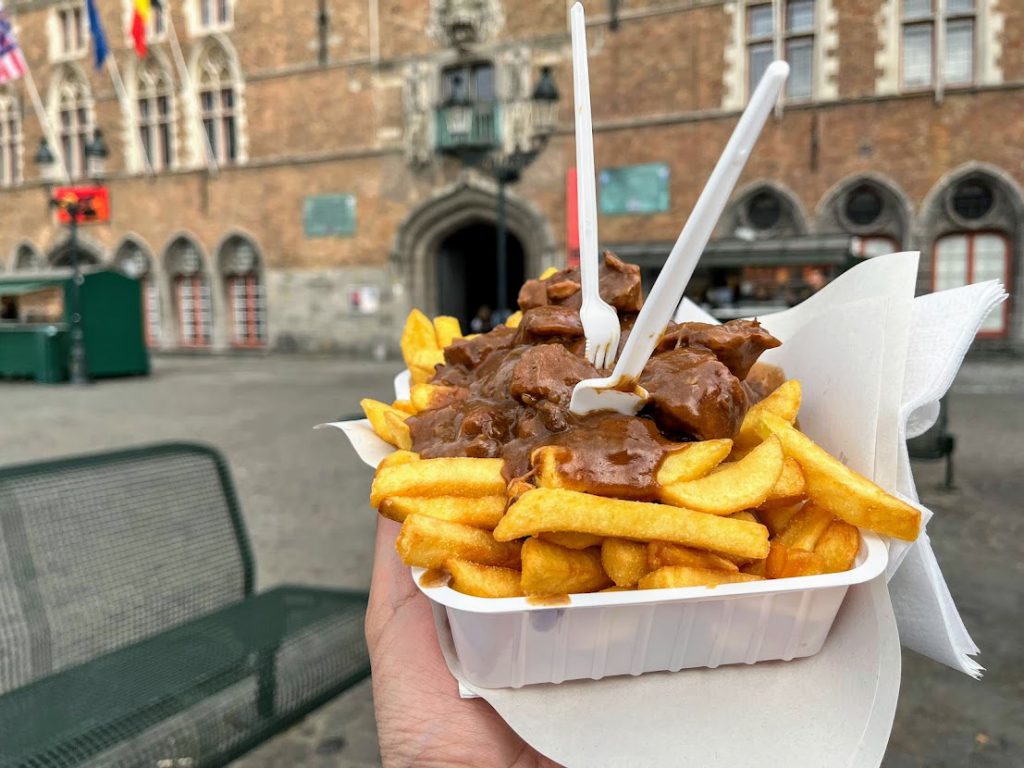

At the base of the belfry there are some food trucks selling fries and other foods. We stopped several times during our stay to enjoy some of their fries. In Belgium, fries are fried twice, giving them a crispy exterior and delicious flavor.
They have a variety of sauces to choose from, my favorites were the curry sauce and the andalouse sauce.
You can also get them topped with Flemish stew, a popular dish in the region.
Groeninge Museum


If you’re an art lover, you’ll enjoy taking some time to look around Groeninge Museum. The museum is dedicated to Belgian artists, with one of the highlights being the work of the Flemish primitives such as Jan van Eyck and Hans Memling.
The museum costs €14 for adults and €12 for ages 12-25 (under 12 is free). It is also included in the Musea Bruges Pass.
Gruuthusemuseum
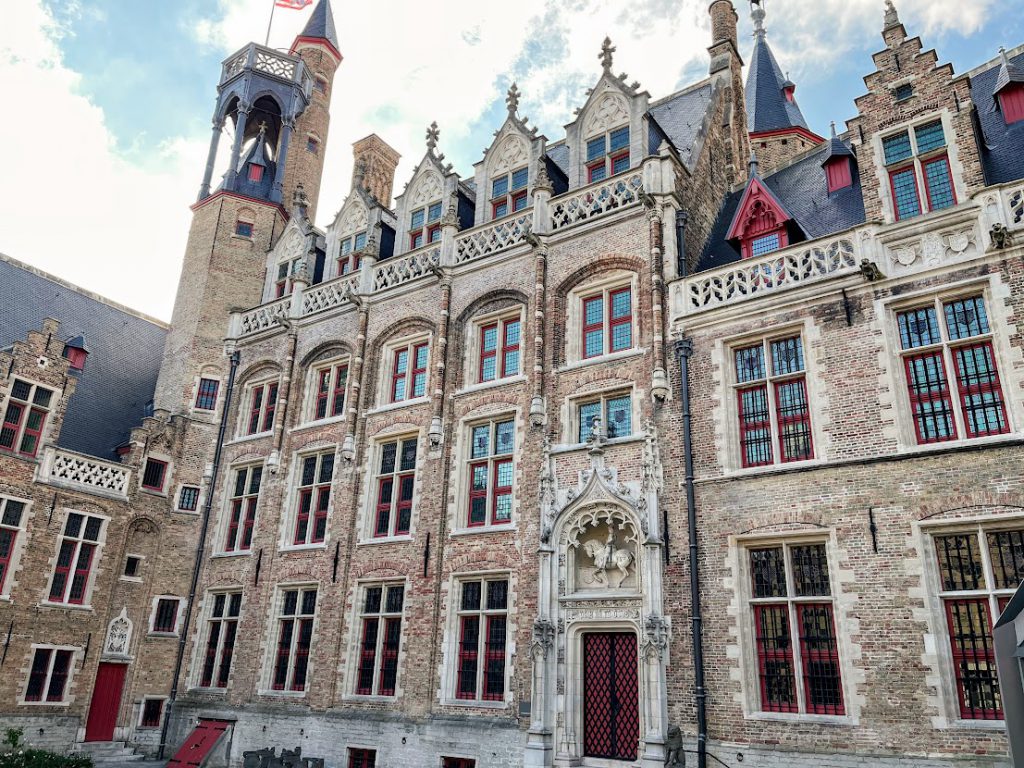

Housed in the mansion of the Lords of Gruuthuse, one of the wealthiest families of the medieval era in Bruges, this museum is a hidden gem. It contains a diverse and fascinating collection of antiques and historical items from the wealthy families of the day and provides an overview of the history of the area.
And the building itself is spectacular, having been restored to its former glory. One of the highlights was the private chapel of Louis de Gruuthuse, from which he and his wife could look down into the Church of Our Lady from the comfort of their home in their own luxurious box.
Be sure to get the audio tour, as it is extremely informative and interesting. Although we intended to rush through this museum, we ended up spending several hours here perusing the exhibits. It was a much more engrossing experience than we had anticipated and we would definitely recommend it to those visiting Bruges.
This museum is included in the Musea Bruges Card. If you don’t have the card, it costs €14 for adults and €12 for ages 12-25 (under 12 is free)
Church of Our Lady
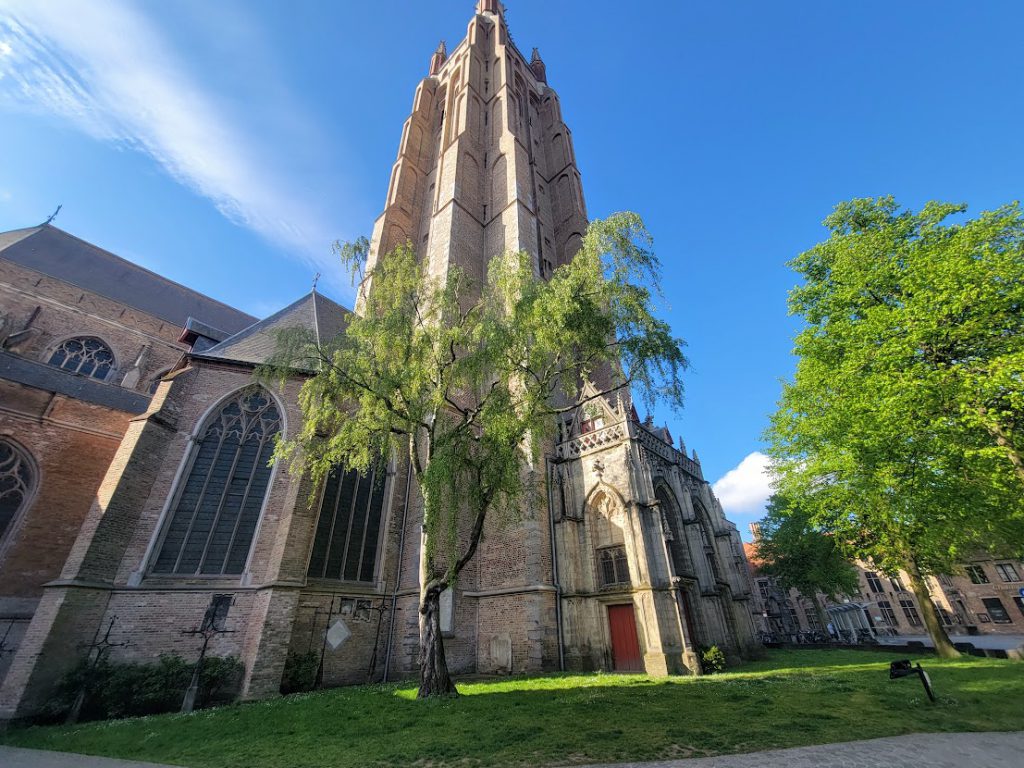

Located next door to the Gruuthusemuseum, this striking Gothic church dates back to the 13th century. At nearly 380 feet tall, the spire is the second highest brick tower in the world.
One of the most noteworthy features of the church is that it is home to Michelangelo’s white marble sculpture Madonna and Child, one of the few sculptures of the artist to be found outside of Italy.
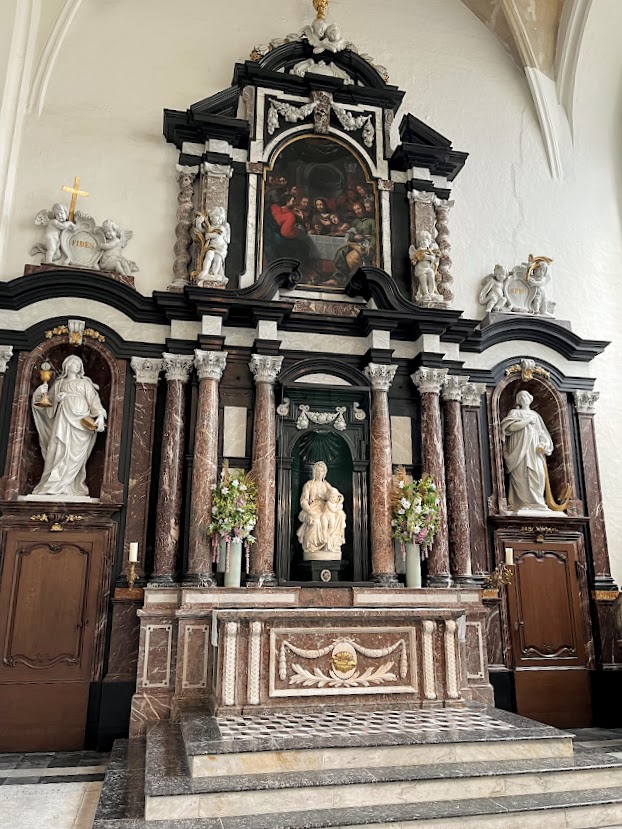

The church also contains the tombs of Charles the Bold and Mary of Burgundy.
Entrance to the church is free, but it costs €7 to visit the museum where you can see the Madonna (entrance to the museum is included in the Musea Bruges Card).
Take a stroll around Minnewater Lake


From Church of Our Lady, it’s another ten minute walk to the south to get to Minnewater Lake. Also known as the Lake of Love, this peaceful and romantic location is a lovely place to relax and enjoy the scenery.
Legend has it that if you kiss your lover on the bridge, your love will become eternal.
This is one area where you can escape the tourists and enjoy the tranquility of the area as you walk through the luscious green park, stroll across the bridges, and admire the swans floating on the lake.
Day 2
Rozenhoedkaai
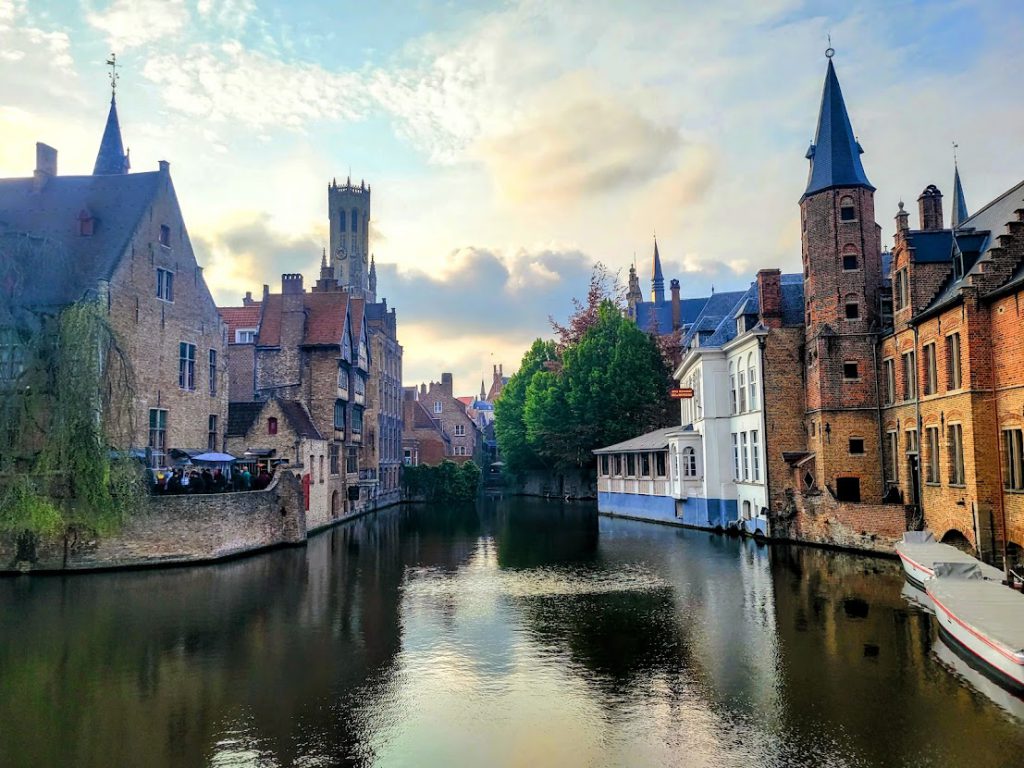

For day two of your weekend in Bruges, start off by spending a few minutes at Rozenhoedkaai, or Rosary Quay. Here where the Groenerei and Dijver Canals intersect you’ll find a lovely scene with well-preserved medieval buildings lining the waterway.
This is the most photographed spot in the city and it’s a charming place to spend some time appreciating the historic vibe of the city. And of course to take a few pictures.
Visit first thing in the morning or in the evening to have the whole place to yourself. If you go in the middle of the day you’ll be fighting the crowds to get that perfect shot.
Canal tour
After taking in the sights at Rozenhoedkaai, head out on a canal tour to see the city from the waterways. This unique experience will give you a whole new perspective on the historic town.
In a city famous for its canals, it’s really a must to take the opportunity to see it by boat. Knowledgeable guides point out sites of interest and give a historical background of the city.
A 30 minute boat tour costs €12 for adults and €7 for children ages 4-11 (children ages 3 and under are free).
You can purchase tickets at any one of the booths along the waterway.
Grab a waffle and some chocolate


While you’re in Bruges you absolutely have to try the waffles and the chocolate, preferably multiple times. How can you visit Belgium and not try some of its most famous delicacies?
I made it a point to stop at as many chocolate shops as possible, you know, for research purposes…
And of course the waffles are to die for. The Belgian sugar waffles (also known as liege waffles) have pearl sugar mixed into the batter, which gives them delicious flavor and sweetness.
During your weekend in Bruges you’ll have plenty of opportunities to sample the chocolate and waffles from the many, many shops in the city!
Choco-Story Chocolate Museum
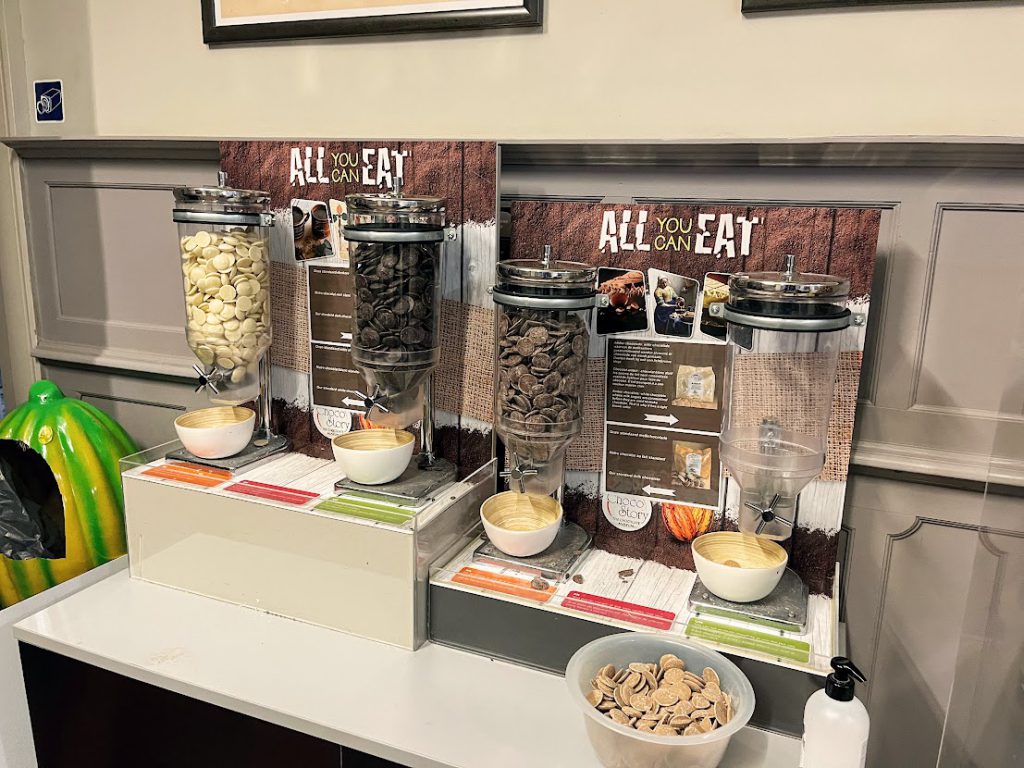

While you’re in Bruges, take the opportunity to learn about (and eat!) chocolate! This interactive museum takes you through the history of chocolate, starting with the Mayans on through today. I highly recommend the audio tour, which provides all sorts of interesting facts and stories as you make your way through the exhibits. It takes around an hour and a half to make it all the way through the audio tour if you listen to each entry.
There are also interactive displays for children throughout the museum to keep the little ones entertained.
At the end of the tour you can watch a demonstration on how to make chocolate pralines and then sample one of the finished products.
There’s also a section at the end where you can sample chocolate buttons of the different kinds of chocolate- milk, dark, white, and amber. And it’s all you can eat (you just can’t take any away with you), so take your time to indulge!
We didn’t really know what to expect when we went to the museum, but left completely delighted with the very interesting (and delicious!) experience. Highly recommended.
This museum is not included in the Musea Bruges Card. It costs €11 for adults and €6.50 for children ages 3-11 (free for children ages 2 and under). You can also get a combination ticket with the Belgian Fries Museum for €16.
In the same building you can find the Lumina Domestica, a light museum. We weren’t all that impressed by the exhibits and would recommend prioritizing other museums over that one.
Frietmuseum (Potato fry museum)
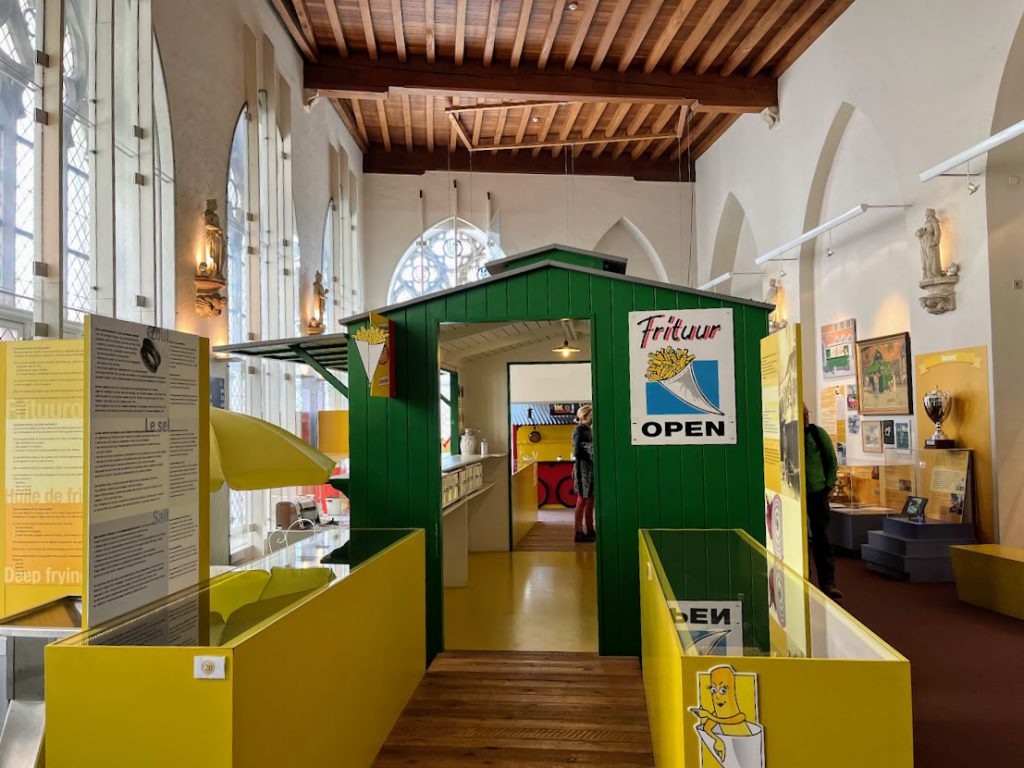

Self-described as the first and only potato fry museum in the world, the Frietmuseum will teach you everything you never knew you didn’t know about fries.
If you’re visiting Belgium, you’ll quickly learn that fries originated in Belgium, not France. The story goes that during WWI some American soldiers were introduced to the fries when they fought in Belgium, but since the Belgian soldiers spoke French the Americans assumed the fries were of French origin. So it’s only fitting to have a museum dedicated to fries in the place they were invented.
As you make your way through the museum, you can learn about the history of potatoes and the development of the fries that we know and love today. There’s an audio tour that provides extra insights to the exhibits.
At the end is a fry shop where you can buy some delicious fries and try the fry sauces. You get a discount with your museum entrance.
If you find yourself short on time I would recommend prioritizing the chocolate museum over this one, but they are both interesting and well worth a visit.
Entrance costs €8 for adults and €6 for children ages 3-11 (children under 3 are free). You can get the combiticket with Choco-Story for €16, €10 for ages 3-11. The Frietmusuem is not included in the Musea Bruges Card.
Museum of Folk Life
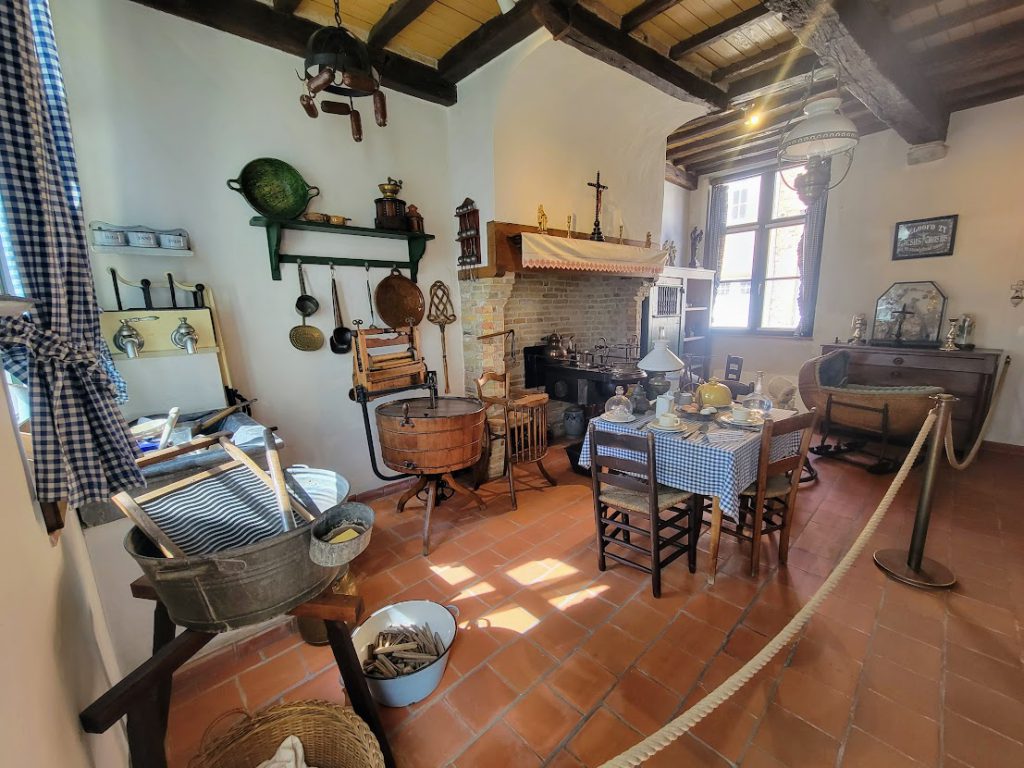

As you make your way towards the windmills from the city center, stop by Volkskundemuseum, the Museum of Folk Life. This is a lesser known museum but it really is a hidden gem on the outskirts of the city. It’s a small museum depicting the way of life in the Netherlands in the 19th and 20th centuries.
Each room showcases a different part of life such as a classroom, a pharmacy, a grocery shop, a tailor, and so on. There are a lot of interactive elements for kids as well, making it a fun visit for the whole family.
In the interior courtyard you can play games from that time period for a fun and hands on cultural experience.
It won’t take you long to make it through the museum, but it’s an interesting place to spend some time. And since it’s out of the city center, it’s much less crowded than the other museums in the city. When we visited we were the only ones there!
This museum is included in the Musea Bruges Card. If not using the card, it costs €7 for adults, €6 for ages 13-25, and is free for ages 12 and under.
Visit the windmills of Bruges
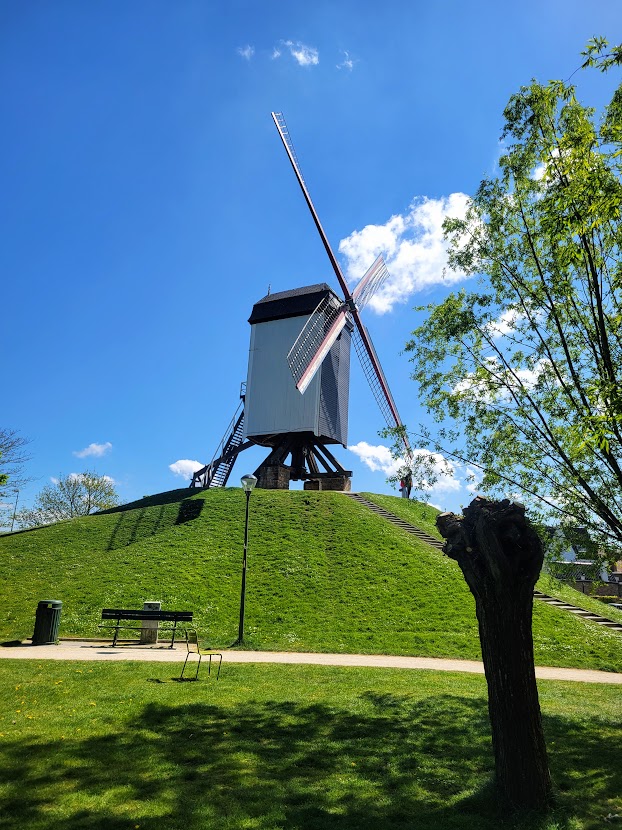

Along the ramparts to the east of the city you can find a group of four picturesque windmills.
It takes about twenty minutes to walk from the city center to the windmills, but along the way you’ll see some of the charming backstreets of the city and have an opportunity to get away from the crowds.
It takes about ten ten minutes to walk from the northernmost windmill to the southernmost windmill. The path takes you on a scenic route along the canal and is the perfect way to unwind after a long day.
If you only have time to visit one windmill, be sure to stop by Sint-Janshuismolen. This is the only windmill that is open to the public. Inside the mill is a small museum which provides some details about how the windmill works.
This is an active mill that is still used to grind flour today, so you can actually see the mill in action when you visit.
The climb up into the mill is extremely steep, so it might not be for those who are nervous about heights. And remember that it’s worse going down than it is going up.
Entrance to the mill is included in the Musea Bruges Card. When paid separately, it costs €4 for adults, €3 for youth ages 13-25, and entrance is free for children 12 and under.
Common questions about a weekend in Bruges
When to visit Bruges
Bruges is a very popular tourist destination, and for good reason. However, that means that the city can get very crowded, especially in the summer months.
Because Bruges gets so busy in the summer, the best time to visit is in the late spring and early fall. During April to May and September to October the weather is typically still quite pleasant but you avoid the busiest tourist season in the city.
Is two days in Bruges enough?
Two days is a perfect amount of time to get a good feel for this historic city without feeling rushed. You will be able to see the main attractions in the historical city center but also venture out a bit to some of the best sites on the outskirts of the city.
Of course you can choose to do a day trip to Bruges (and many do), but in that limited time you won’t be able to fit in all the best attractions the city has to offer.
One of the biggest benefits of spending a weekend in Bruges is that you will be there in the early morning and evening, when many of the tourists have already departed. Because Bruges is such a popular day trip destination, hoards of tourists arrive on the tour buses in the morning and head out in the afternoon.
After pushing through the crowds of tourists all day, we were shocked to find that we had the place mostly to ourselves come evening. It was incredibly refreshing to be able to have time to explore the city without the masses.
And then in the morning, we found that it wasn’t until around 10 or so that the crowds really started descending on the city again. Time it right and you have quite a bit of time to enjoy the city in relative peace!
How to get to Bruges?
Probably the most convenient and economical way to get to Bruges is by train.
If you’re coming from Brussels (the location of the nearest international airport), the train ride typically takes just over an hour and costs about €16.
From Ghent, it takes about 24 minutes by train to get to Bruges.
Where to stay in Bruges?
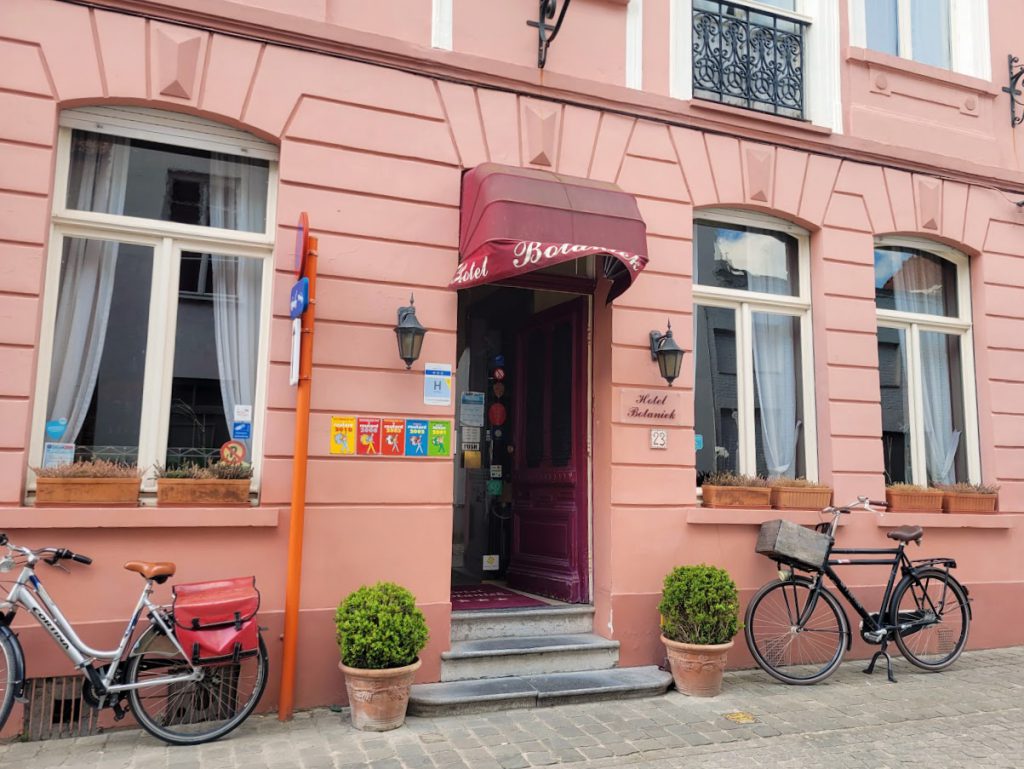

There are many great options of places to stay during your weekend in Bruges. It’s in your best interest to get a hotel near the center of the city so that you can minimize travel time getting to and from the attractions each day.
While we were there we stayed at Hotel Botaniek, a charming and centrally located boutique hotel. The hotel is a renovated 18th century mansion located on a quiet street only a quick five minute walk from the city center.
A stay includes a delicious European breakfast in the lovely breakfast room.
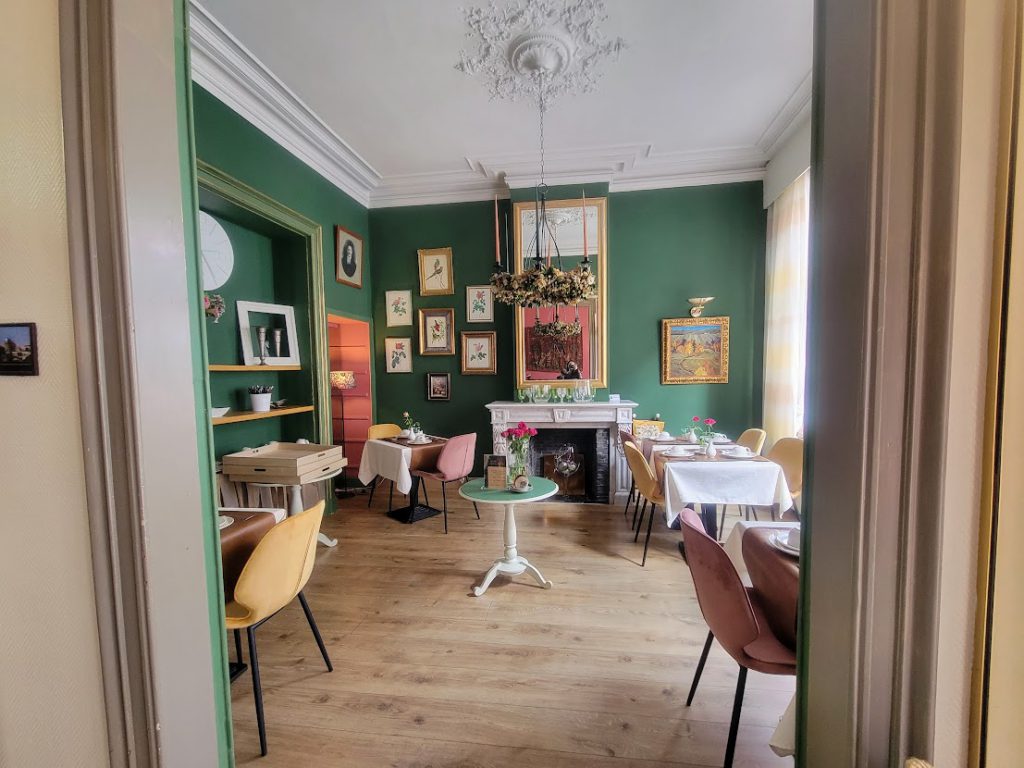

Everything is tastefully decorated, the owners are extremely helpful, and there’s even an elevator to reach the upper floors. We would highly recommend this quaint hotel for your stay in Bruges.
Is the Musea Bruges Card worth it?
In order to save money on the attractions in Bruges, consider purchasing the museum card, which includes access to 13 museums in Bruges, including the belfry, City Hall, and Windmill Museum (Sint-Janshuis Mill). You can buy your pass online or inside the City Hall (Stadhuis).
The Musea Bruges Card costs €32 (€24 for ages 13-25 and free for those under 13) and is active for 72 hours after you first use it.
If you plan on visiting more than just two of the museums, purchasing the pass will likely be a good investment for your weekend in Bruges. For the itinerary that we’ve provided here, the Musea Bruges Card is well worth the cost and will save you quite a bit of money.
Note that museums in Bruges are closed on Mondays, so plan accordingly!
You can purchase a Museum Card here.
(There used to be a Bruges City Card, which included a lot of the main attractions as well as access to public transportation. However, that card does not exist anymore. When we were planning our trip we kept seeing this card referenced, so I thought I’d save you some time with this tidbit of information.)
Final Thoughts
Taking a trip to Bruges is like taking a step back into medieval times. The scenic city is full of well-preserved historical buildings, fascinating museums, and narrow canals with scenic views.
A weekend in Bruges will give you the perfect amount of time to see all the best sights with this two day itinerary. It will be a weekend that you won’t soon forget!
Other posts you might be interested in:
A Perfect Itinerary for One Day in Ghent



